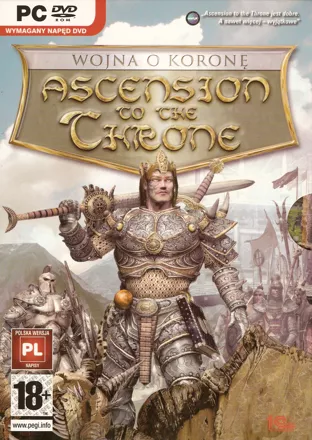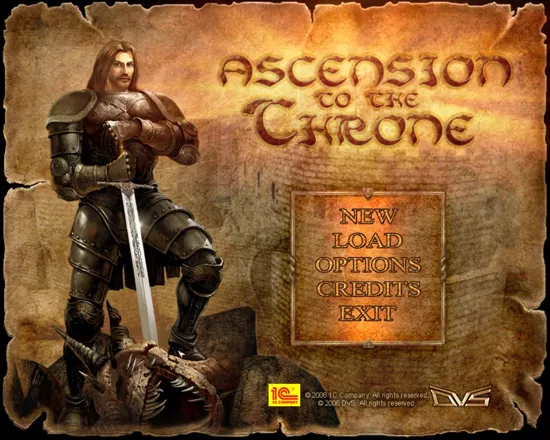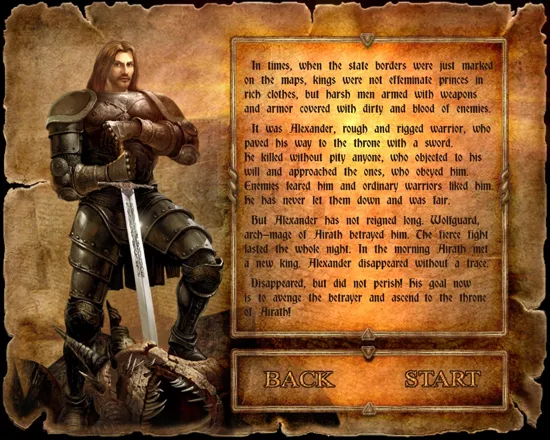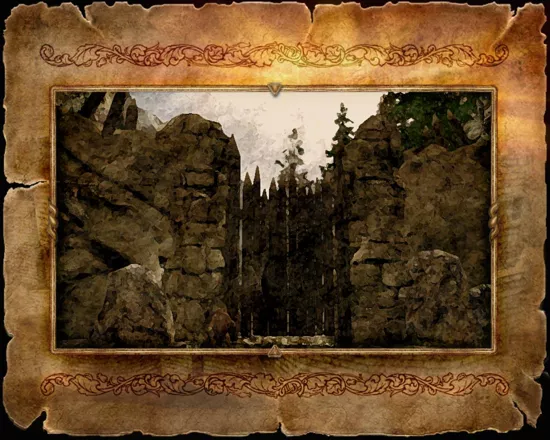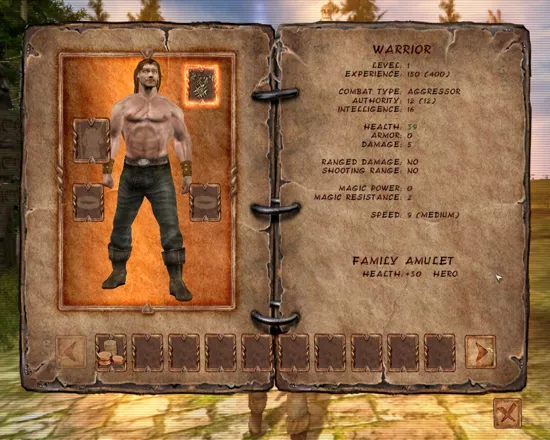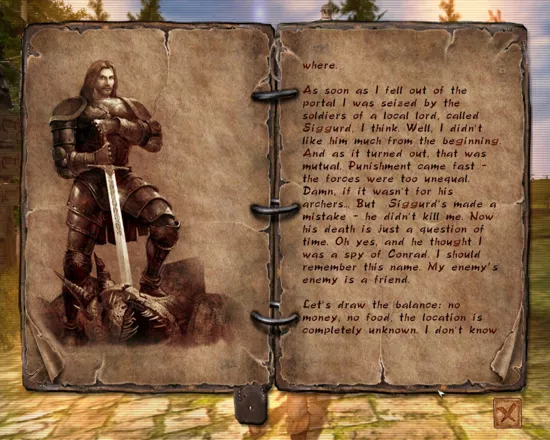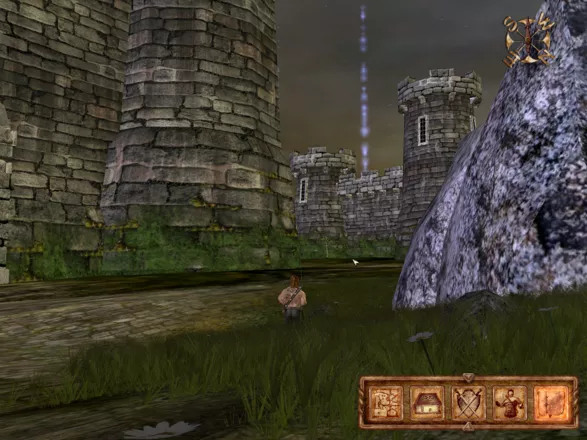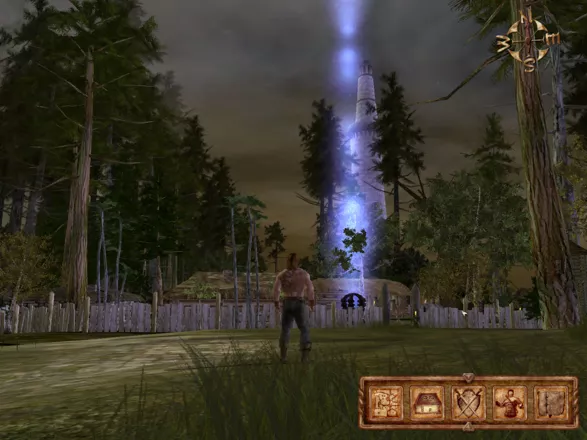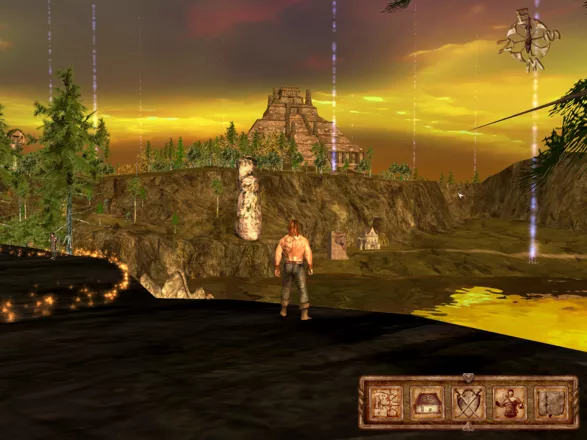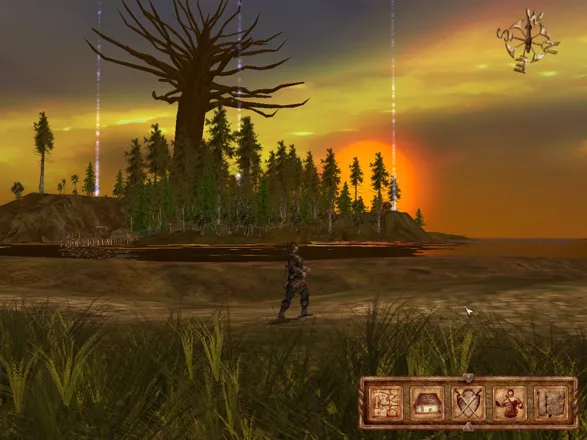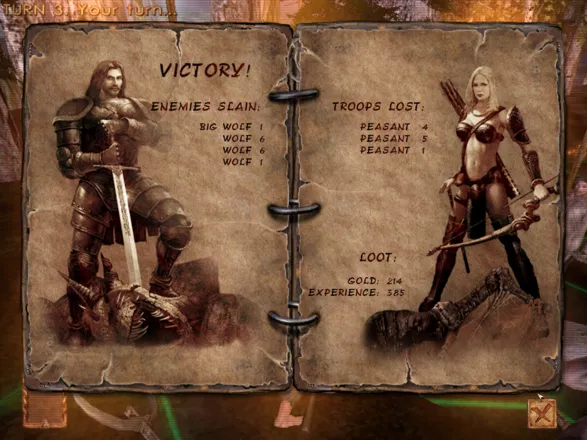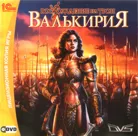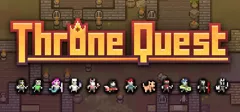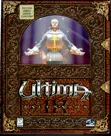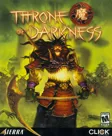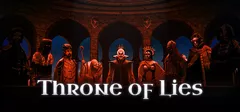Ascension to the Throne
Description official description
In Ascension to the Throne the player takes the role of Alexander, king of Airath. After the betrayal of the magician Wolgard he barely saved his life and now his goal is to build an army to regain his kingdom.
The game is a mixture between RPG and turn-based strategy game. When exploring the environment the player sees Alexander from behind. He talks to people in multiple-choice conversations, takes quests, finds treasures, buys equipment with earned money and hires mercenaries.
When walking the player meets especially marked enemies which cause the game to switch to a turn-based combat screen with hex fields. These enemies don't leave their position in the game world and can be avoided unless they stand in a narrow place. In the combat itself the player starts by positioning his army and then he gives order to his troops every turn, e.g to move, to attack or to cast a spell. If Alexander dies the game ends instantly.
The player's army consists of ten slots: Alexander and other plot-related characters take up one each, the other ones can be filled with up to ten troops of the same kind. With a few exceptions the player has to pay troops with so-called authority points which are mostly gained during level-ups, after certain quests and by dividing found treasures between the army. The player also can improve other stats when having enough experience points which influence Alexander's armor, damage and magic abilities.
Spellings
- Восхождение на трон - Russian spelling
Groups +
Screenshots
Promos
Videos
Add Trailer or Gameplay Video +1 point
See any errors or missing info for this game?
You can submit a correction, contribute trivia, add to a game group, add a related site or alternate title.
Credits (Windows version)
42 People (39 developers, 3 thanks) · View all
| Project Leader | |
| Lead Programmer | |
| Programmers | |
| Lead Artist | |
| Artists | |
| Lead Game Designer | |
| Game Designers | |
| Animator | |
| Music | |
| Uses BINK Video by |
|
| Uses Miles Sound System by |
|
| Sound Producer | |
| Video Director | |
| Producers | |
| Tech Producer | |
| Artists | |
| [ full credits ] | |
Reviews
Critics
Average score: 63% (based on 10 ratings)
Players
Average score: 3.7 out of 5 (based on 8 ratings with 1 reviews)
Quite a power trip, with low production values and some bad design choices.
The Good
Ascension to the Throne does a few interesting things with the combat, and that’s even more important when the combat is pretty much the only aspect it has going for it. Well, that and the fact that it’s quite a power trip, which is good from where I’m standing, though those looking for a challenge will disagree. But I was talking about the interesting elements in combat, and the most obvious one is the fact that, while you can stack up to ten units of the same type in each slot, the units are displayed and treated individually, and this changes the tactics significantly.
The most obvious effect is the fact that each attacker dealing physical damage can only attack one target at a time. Then, the number of free hexes around each member of the target group determines the maximum number of potential melee attackers, offering ways to protect units. Ranged attackers don’t have this problem and their shots ignore obstacles, but each of them is still limited to shooting a single enemy unit at a time. In addition, while units can move and then perform a melee attack, and their movement range is even extended in order to allow striking any and all units in the target group if the normal movement range allows attacking at least one, they can’t both move and shoot, or cast a spell, in the same turn, and ranged attacks also can’t be performed if an enemy unit is right next to any unit from the group. Nevertheless, melee units that aren’t very fast may tend to become irrelevant rather quickly, though those that are very fast can be used to great effect, both for and against you. As for spells, the spell power and intelligence of all casters in a group is added together, but direct damage spells usually have a maximum number of units they can strike, the others in the target group being unaffected, while the power of other spell effects is divided by the number of units in the target group to determine the effect applied to each. This means it makes sense for magic resistance to reduce the power of the effects on each target, but it’s rather strange when armor acts in the same manner, reducing the total damage taken by each unit struck instead of the damage dealt by each attacker.
Your tactics need to take all of that into account, and what truly helps is that there’s no randomization, so you can truly calculate what will happen. There are no chances to hit, no damage ranges, and even the order of movement is set, the criteria used being, in order, speed, whether the unit is in the front row, and the exact position, counting from the top. If all are equal, your unit will move before the enemy’s, and there are actually a few battles that’d be unwinnable otherwise, seeing as it’s game over the moment the main character gets killed and the AI will usually prioritize doing so if possible. However, while not bad overall, said AI can easily be tricked into using spellcasters to attack other units, and I wonder if that isn’t actually intentional, considering the units faced late in the game.
As I already mentioned, while those looking for a challenge definitely won’t, another thing I enjoyed was the fact that the game is quite a power trip, and accepting some early pain, which isn’t really that much after the earliest stages, makes for even greater gains towards the end. Yes, in the beginning you will be searching for that next fight you can survive, and after a while there may be one battle that may dishearten you, which may lead to deciding to use a raft to get around it only to find that they only go one way and you’re stuck, too weak to either advance or fight your way back, but past that point it just keeps getting easier.
One thing to keep in mind is that, on top of the value of each skill point being equal to the level it was gained at, enhancing that feeling of power as the character improves more and more each time, the rewards also scale with level, so complete quests, use altars, open chests or do anything else that offers a reward as late as possible, leaving as many as you can afford for the very end if you want to end up with the best possible character. And you can also customize the benefits, each altar offering a choice of two attributes to raise, and some situations offering other choices, the only false choice being that offered by chests, as it’s never worth taking the money for yourself.
Even leaving all those rewards for the end, by actually buying the best units you can, swapping what you have for them if room is needed, you should usually avoid tricky situations, but it’s definitely possible to finish the game with few purchased units and little cannon fodder, keeping most of what you end up with around long after better options become available, creating a certain level of difficulty through your own choices and obtaining that feeling of sort of caring for the units, necessary for me to feel comfortable while playing. As a curiosity, the army I first finished the game with included a single purchased unit, the “mandatory” conqueror, the other six slots that are open at that point being filled with the one other more powerful named unit that may join and a handful of other units that join for free later in the game. It made for a difficult final battle and I died the first time, but it worked out on the second try, with a lot of care. And then, just to see what was possible, I reloaded the save from before that final series of battles and properly filled my army with a mix of powerful units, which made even those battles a joke.
Otherwise, a fair amount of attention was given to journal entries, and my complaints about the quality of the writing can’t really apply, since it’s supposed to be a journal, not a book, and it does look like one. But to return to the elements that ensure that the player is in control, another one is that, with the exception of a few scripted battles, you can see the enemies and they will turn to face you if you approach, but they will never attack on their own, and when you get close enough you’ll see a prompt asking whether you want to fight and listing the numbers and types of enemies, including how they’re grouped. Considering all these things, it’s not exactly necessary for it to autosave before each battle, but the fact that it does is another safety net for those who want it… And it may become necessary in order to continue in one or two places, due to bugs I’ll explain below. On the other hand, I’m not sure how to take the fact that units available to recruit completely replenish over the course of one day, so there’s no need to keep them alive if you can afford to replace them. But I can’t consider it a bad thing, since it doesn’t hurt those like me, who play defensively, and those playing aggressively will have one less thing to worry about.
The Bad
When it comes to the negative aspects, I must unfortunately start with the bugs. Nothing that will break the game if you’re a little careful, and perhaps make use of an autosave in one or two places, if needed, but there are quite a number of them and the reason why you need to be a little careful is that the things that should happen at the end of a conversation may not happen completely if you click through it quickly. Since it’d be far from the only text bug, I don’t know if this was the reason why I couldn’t talk to Conrad’s blacksmith after he told me to do so in order to get better equipment, but it was quite clearly the reason why the game froze at one point, and missing out on rewards is even more likely if you hurry. And it is, of course, possible for events necessary for continuing to fail to trigger, so you’re better off waiting for any other text that may show up to clear before clicking to end the conversation, and waiting for the last line to go away on its own or, if it’s a longer piece, at least giving it several seconds before clicking, if there’s no other text.
Another problem is that the game crashed quite a number of times, and a crash meant that it appeared to freeze, a window with an error appearing but needing me to hit Alt+Tab in order to see it and have the game actually close, after I clicked to close that error. These crashes usually happened at the start of battles and they were far more likely when there were multiple battles chained together, even more so if the character gained a level between such battles, and actually taking advantage of the level up animation in order to use those new skill points and/or rearrange your army made the crash pretty much a certainty. There was one place where using the autosave made before the last battle in a chain was the only way to continue, but I otherwise avoided loading autosaves, being able to do so since it worked at the second or third attempt in all other cases. The reason why I avoided loading autosaves was that I was worried that they may be somehow damaged, especially if the game crashed at that point, but also because if you load any save during battle, you’ll be faced with the prompt about starting that battle, as if you’d have loaded the autosave made before it, but all other data will be loaded from the save file you actually chose, so something seemed too strange. Had no problems as a result of loading that autosave though, nor with any other save files.
Other bugs I noticed included the fact that the character “teleported” a few times while walking, a short distance from where he was. Or that, if you have the combat instructor join you before being thrown there by the magic barrier, you’ll still have that conversation, looking like the air is talking back to you, but if you have the pilgrim join you too soon, there’s no way to get the answer to your question, though you’re admittedly able to ask for help when you reach the correct NPC even if you haven’t been told to see him. So a potentially worse problem is that the journal became unreadable, all entries appearing blank, a few times, I believe the reason being that a journal entry was added in a conversation that also allowed me to learn new spells and I did so, though it’s also possible that it was just another result of clicking to end the conversation too quickly. No idea if this can be fixed later, as I noticed it immediately and reloaded my previous save.
Moving on to text bugs, I’m sure there are more, but let’s see… The journal entry after clearing the enemies around Steelberg says you received a ring protecting against magic, but it’s in fact one protecting against physical attacks. The entry for closing the portals says that endless undead came out before you focused on the mages, but you only fight mages. You’re told to recruit as many troops as you can in Giantsville, but there’s no way to recruit any. And a particularly notable one has to do with the Old Temple quest, which seems to be a case of an idea being discarded but the journal entry being written before that happened and not changed, since said entry states that, as a reward, the monk offered to perform a ritual allowing you to resurrect if you fall in battle, but he doesn’t say so in the conversation and if you try to talk to him again at the temple you can’t say anything, can just pass by.
I’ll end this section with quite a chain of issues towards the end. You’re supposed to enter alone, without your army, and the journal entry says that you should be able to deploy it at a caravanserai, but there’s nobody you can talk to if you go there and will in fact enter with your army just fine. All conversations and journal entries will still say that you’re alone though, excepting the few units you can recruit inside. This may actually cause problems with what you can recruit, and I know it does for the group you receive when you leave, which is lost if you don’t have free slots, as you’re not asked to make some room and then try again. In addition, while a group leaves those you can see before the start of the battle, opening the gates doesn’t seem to actually affect the enemies you face in the battle itself. As for getting your armor back before that battle, I’d sure like to know how, because you’re told to meet the guy in a certain place and there would seem to be a way to get around the guards, but they still saw me even if I hugged the wall. And not that it matters, but it seems that you won’t get the soldier clothes, so the first and weakest equipment set, back when you do talk to that guy again.
I’m not sure whether a couple of oddities having to do with active spell effects are also bugs or bad design choices, so I’m adding them separately. One is that choosing to wait will cause that turn to count as two for the active spell effects, so the duration will be reduced by one, and in case of those particular spells the damage or regeneration will be applied, both when the unit’s turn initially comes and when it’ll get the next chance to act, after choosing to wait. And the other is that I sometimes got the impression that the duration of the effects is counted more accurately than in turns, so an effect with one turn left may vanish before the unit’s next move.
Something that’s clearly a bad design choice is that healing works just like any other spell, the effect being divided equally between the units in the target group instead of healing those that need it as much as possible, or at least working as an attack, allowing one specific unit to be selected, the game determining which others any remaining power goes to, prioritizing those with lower health. But now that I mentioned how attacking works, I must emphasize what an unbelievably bad design choice that is. Units are treated as individuals, not stacks, but when a group attacks another group, or when a spell that can’t affect all the units in the target group is used, you can only choose the first specific unit to target, the game determining the others, focusing on those that can be killed if they exist. If you want to spread attacks differently, possibly to “soften” a group in order to kill more with a later attack, you can’t. And, while I’m at it, movement works the same way, with only a single hex being selected as the destination, the exact positioning of the units in the group in that area being determined by the game. In addition, while when you attack you can at least see the damage that will be dealt as you hover over the target group, in case of movement you can only click directly, the positioning of the units at the destination being shown after you do.
Past that, the story is generic, mainly only there to push you from one battle to the next. But the feeling of power and the battles themselves can probably do that well enough, so it’s the conversations with NPCs that I’d consider more of a negative aspect, as quite a number of times they’re laughable, and by that I don’t mean intentionally humorous. Wonder how much of that is a case of lost in translation though, the developers being Russian. And, while I’m at it, a conversation is the only way to interact with stores as well. An interface for learning spells is created by adding a little more information to the one for casting them, and that for recruiting troops is similarly created out of the army one, but you can only talk to shopkeepers and ask them to describe the items they sell, one at a time. Admittedly, this doesn’t take long, since each shopkeeper has at most two items to sell. And no, with the exception of one suit of armor, you can’t sell anything back.
It does look like the developers had very limited resources to work with, and that shows very clearly even in Oganthar, which is by far the most developed area, the later ones clearly being rushed. The different regions follow pretty much the same pattern, and while the buildings do look different, the other assets are reused everywhere. It’s strange that some locations seem to lack some of the standard NPCs without any explanation though. But I’d say that an even clearer sign of rushing is the walk to Suntown or Arthur’s Castle, and then all the way to the back of Gilbert’s Castle and that quest location. That’s the last part of “mainland” Oganthar you’ll reach, and you’ll have no events, quests, NPCs or battles during that long walk.
What makes the exploration aspect even worse is that you can’t really explore even what is there. What would be obvious access routes are permanently closed off, there are invisible walls everywhere, can’t climb anything, can’t jump at all… Yes, if there’s nothing relevant past those invisible walls or impassable tiny obstacles, being able to go there might have done little to improve the impression. However, I found one spot, in Annaroth, where I could break through the invisible wall and wander all over the mountains, which offered some interesting views, and also allowed me to actually go to a ruin that I guess was just placed there as a piece of scenery to be seen from below. No rewards, no battles, but I rather enjoyed simply being allowed to freely explore for a while.
The graphics and animations also indicate the low production value, and the very short draw distance for scenery objects and textures, and the fact that they just pop in when you get that close, is rather strange, but that’s not something that can bother me in itself. What did at times get on my nerves, on the other hand, was that constant clinking of armor while moving. The lack of a minimap was also occasionally frustrating, but the map can be used to get your bearings well enough. And I’ll also add here that certain elements that seem intended for Valkyrie, such as rings from shops and even an altar intended for a ranged attacker, are placed in the game and unusable, the hero stating that they’re useless for him, though Eneya does take one ring you find in a chest… And that’s also the only time when a named unit improves while in your army, the other improvements to those you need to have with you happening when they return after some time away, while the optional named units never improve at all.
The Bottom Line
In the end, Ascension to the Throne is quite a power trip, and may be seen as a decent effort overall if the resources available to the developers were indeed the limiting factor. There are bugs, but nothing breaking the game, any quest or character development if you’re a little careful. The story is generic and exploration is severely restricted and not that interesting to begin with, but there’s enough content for this type of game and the gameplay is, after all, defined mainly by the battles and the feeling of increasing power. And Ascension to the Throne does a great job when it comes to the latter aspect, albeit too good of a job for those looking for a challenge. As for the former, there are some interesting concepts, even if part of the potential is wasted due to some bad design choices. Not a game you need to play by any stretch of the term, but definitely one you can play if you enjoy the genre.
Windows · by Cavalary (11635) · 2020
Analytics
Identifiers +
Contribute
Are you familiar with this game? Help document and preserve this entry in video game history! If your contribution is approved, you will earn points and be credited as a contributor.
Contributors to this Entry
Game added by Patrick Bregger.
Additional contributors: Havoc Crow, Klaster_1.
Game added December 27, 2009. Last modified November 22, 2024.


